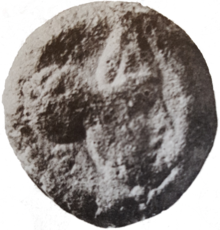
Back Odaenathus Afrikaans أذينة (ملك تدمر) Arabic اذينه ARZ اذینه AZB Септымій Адэнат ІІ Byelorussian Оденат Bulgarian Odenat Catalan Septimius Odaenathus German Οδαίναθος Greek Septimio Odenato Spanish
| Odaenathus 𐡠𐡣𐡩𐡮𐡶 | |||||
|---|---|---|---|---|---|
| King of Palmyra King of Kings of the East (Western Aramaic: Mlk Mlk dy Mdnh) | |||||
 | |||||
| King of Kings of the East | |||||
| Reign | 263–267 | ||||
| Predecessor | Title created | ||||
| Successor | Vaballathus | ||||
| Co-ruler | Hairan I | ||||
| King of Palmyra | |||||
| Reign | 260–267 | ||||
| Predecessor | Himself as Ras of Palmyra | ||||
| Successor | Vaballathus | ||||
| Ras (lord) of Palmyra | |||||
| Reign | 240s–260 | ||||
| Predecessor | Office established | ||||
| Successor | Himself as King of Palmyra | ||||
| Born | c. 220 Palmyra, Roman Syria | ||||
| Died | 267 (aged 46–47) Heraclea Pontica (modern-day Karadeniz Ereğli, Turkey), or Emesa (modern-day Homs, Syria) | ||||
| Spouse | Zenobia | ||||
| Issue | Hairan I (Herodianus) Vaballathus Hairan II | ||||
| |||||
| House | House of Odaenathus | ||||
| Father | Hairan | ||||
Septimius Odaenathus (Palmyrene Aramaic: 𐡠𐡣𐡩𐡮𐡶, ʾŌdainaṯ; Arabic: أذينة, romanized: Uḏaina; c. 220 – 267) was the founder king (Mlk) of the Palmyrene Kingdom who ruled from Palmyra, Syria. He elevated the status of his kingdom from a regional center subordinate to Rome into a formidable state in the Near East. Odaenathus was born into an aristocratic Palmyrene family that had received Roman citizenship in the 190s under the Severan dynasty. He was the son of Hairan, the descendant of Nasor. The circumstances surrounding his rise are ambiguous; he became the lord (ras) of the city, a position created for him, as early as the 240s and by 258, he was styled a consularis, indicating a high status in the Roman Empire.
The defeat and captivity of Emperor Valerian at the hands of the Sassanian emperor Shapur I in 260 left the eastern Roman provinces largely at the mercy of the Persians. Odaenathus remained on the side of Rome; assuming the title of king, he led the Palmyrene army, fell upon the Persians before they could cross the Euphrates to the eastern bank, and inflicted upon them a considerable defeat.[1] He took the side of Emperor Gallienus, the son and successor of Valerian, who was facing the attempted usurpation of Fulvius Macrianus. The rebel declared his sons emperors, leaving one in Syria and taking the other with him to Europe. Odaenathus attacked the remaining usurper and quelled the rebellion. He was rewarded with many exceptional titles by the Emperor, who formalized his self-established position in the East. In reality, the Emperor may have done little but accept the declared nominal loyalty of Odaenathus.
In a series of rapid and successful campaigns starting in 262, Odaenathus crossed the Euphrates and recovered Carrhae and Nisibis. He then took the offensive into the heartland of Persia, and arrived at the walls of its capital, Ctesiphon.[1] The city withstood the short siege but Odaenathus reclaimed the entirety of the Roman lands occupied by the Persians since the beginning of their invasions in 252. Odaenathus celebrated his victories and declared himself "King of Kings", crowning his son Herodianus as co-king. By 263, Odaenathus was in effective control of the Levant, Roman Mesopotamia and Anatolia's eastern region.
Odaenathus observed all due formalities towards the Emperor, but in practice ruled as an independent monarch. In 266, he launched a second invasion of Persia but had to abandon the campaign and head north to Bithynia to repel the attacks of Germanic raiders besieging the city of Heraclea Pontica. He was assassinated in 267 during or immediately after the Anatolian campaign, together with Herodianus. The identities of the perpetrator or the instigator are unknown and many stories, accusations and speculations exist in ancient sources. He was succeeded by his son Vaballathus under the regency of his widow Zenobia, who used the power established by Odaenathus to forge the Palmyrene Empire in 270.
- ^ a b Cooke 1911.
© MMXXIII Rich X Search. We shall prevail. All rights reserved. Rich X Search